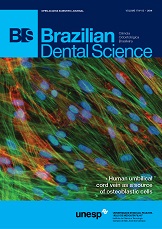Imaging aspects of the dentigerous cyst magnetic in resonance imaging and ultrasound
DOI:
https://doi.org/10.14295/bds.2014.v17i3.970Abstract
Magnetic resonance imaging (MRI) is a type of imaging study considered the gold standard in the analysis of the internal structure and content of intraosseous lesions, allowing for their inherent characteristics of acquisition, determine the nature and differential diagnosis between changes that have aspects Similar to other imaging modalities, such as on radiographs and computed tomography (CT) and also has the great advantage of not being an invasive method, since it does not use ionizing radiation.The ultrasound (U.S.) and MRI provides images without showing deleterious effects to living organisms, enabling the differentiation between solid and cystic lesions, however, lacks the ability of MRI to provide an anatomical detailing determined, nor information about the chemical composition of the lesions, which would be crucial in determining the diagnosis of the same. The dentigerous cyst is among the most frequent odontogenic lesions that affect the maxillomandibular complex, requiring a thorough assessment of its extent and proximity to anatomical structures as well as the differential diagnosis with other lesions. This study aimed to emphasize the use of MRI and U.S. in the diagnosis of lesions dentomaxilofaciais, describing a clinical case of dentigerous cyst in these imaging modalities were used as complementary tests.
Downloads
Downloads
Additional Files
Published
How to Cite
Issue
Section
License
Brazilian Dental Science uses the Creative Commons (CC-BY 4.0) license, thus preserving the integrity of articles in an open access environment. The journal allows the author to retain publishing rights without restrictions.
=================




























